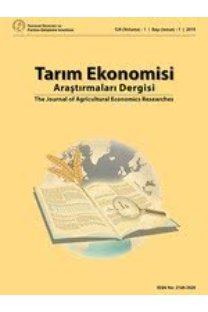Türkiye Ekonomisinde Döviz Kurunun Gıda Fiyatlarına Etkisi ve Döviz Kurunun Sürdürülebilir Gıda Güvencesi İçin Önemi
Gıda Enflasyonu, Fiyatlar Genel Düzeyi, Döviz Kuru, Para Politikası, Gıda Güvencesi
The Effect of Exchange Rate on Food Prices in Turkiye Economy and Importance of Exchange Rate for Sustainable Food Security
Food Inflation, General Price Level, Exchange Rate, Monetary Policy, Food Security,
___
- Alkan, U. & Dağıdır, C. (2020). Türkiye’de Döviz Kuru Ve Enflasyon Arasındaki İlişkinin Çoklu Yapısal Kırılmalı Eşbütünleşme Analizi. Finans Ekonomi ve Sosyal Araştırmalar Dergisi, 5 (2) , 270-287. DOI: 10.29106/fesa.729769
- Breusch, T. S. (1978). Testing for Autocorrelation in Dynamic Linear Models. Australian Economic Papers, 17(31), 334-355. https://doi.org/10.1111/j.1467-8454.1978.tb00635.x
- Breusch, T. S., & Pagan, A. R. (1979). A Simple Test for Heteroscedasticity and Random Coefficient Variation. Econometrica, 47(5), 1287-1294. https://doi.org/10.2307/1911963
- Bush, R. (1996). The Politics of Food and Starvation. Review of African Political Economy, 23(68), 169–195.
- Cohen, B. I. (1968). The Less-Developed Countries’ Exports of Primary Products. The Economic Journal, 78(310), 334–343. https://doi.org/10.2307/2229468
- D’agostino, R. B., Belanger, A., & D’agostino Jr., R. B. (1990). A Suggestion for Using Powerful and Informative Tests of Normality. The American Statistician, 44(4), 316-321. https://doi.org/10.1080/00031305.1990.10475751
- Dickey, D. A., & Fuller, W. A. (1979). Distribution of the Estimators for Autoregressive Time Series With a Unit Root. Journal of the American Statistical Association, 74(366), 427-431. https://doi.org/10.2307/2286348
- Durbin, J., & Watson, G. S. (1950). Testing for Serial Correlation in Least Squares Regression: I. Biometrika, 37(3/4), 409-428. https://doi.org/10.2307/2332391
- Durbin, J., & Watson, G. S. (1951). Testing for Serial Correlation in Least Squares Regression. II. Biometrika, 38(1/2), 159-177. https://doi.org/10.2307/2332325
- Durbin, J., & Watson, G. S. (1971). Testing for Serial Correlation in Least Squares Regression III. Biometrika, 58(1), 1-19. https://doi.org/10.2307/2334313
- Godfrey, L. G. (1978). Testing Against General Autoregressive and Moving Average Error Models when the Regressors Include Lagged Dependent Variables. Econometrica, 46(6), 1293-1301. https://doi.org/10.2307/1913829
- Güngör, S. & Erer, D. (2022). Türkiye’deki Gıda Fiyatları İle Petrol Fiyatları Ve Döviz Kuru Arasındaki Doğrusal Olmayan İlişkinin İncelenmesi: Zamanla-Değişen Parametreli VAR Modelleri. Alanya Akademik Bakış, 6 (2) , 2481-2498. DOI: 10.29023/alanyaakademik.1082332
- Hirschman, A. O. (1949). Devaluation and the Trade Balance: A Note. The Review of Economics and Statistics, 31(1), 50–53. https://doi.org/10.2307/1927193
- İçen, H. , Esenyel İçen, N. M. & Polat, B. (2022). Türkiye’de Gıda Fiyatları, Döviz Kuru ve Petrol Fiyatları Arasındaki Asimetrik İlişki. Ekoist: Journal of Econometrics and Statistics , (37) , 149-169. DOI: 10.26650/ekoist.2022.37.1168678
- Jarque, C. M., & Bera, A. K. (1987). A Test for Normality of Observations and Regression Residuals. International Statistical Review / Revue Internationale de Statistique, 55(2), 163-172. https://doi.org/10.2307/1403192
- Karaoğlu, N. & Demirel, B. (2021). Asymmetric Exchange Rate Pass-Through into Inflation in Turkey: A NARDL Approach. Fiscaoeconomia, 5 (3) , 845-861. DOI: 10.25295/fsecon.925369
- Konak, A. & Peçe, M. A. (2023). Türkiye'de Faiz Oranı, Enflasyon Oranı ve Döviz Kuru Arasındaki Nedensellik Analizi. Türkiye Sosyal Araştırmalar Dergisi, 27 (1) , 171-186. Retrieved from https://dergipark.org.tr/en/pub/tsadergisi/issue/76479/1139318
- Newey, W. K., & West, K. D. (1987). A Simple, Positive Semi-Definite, Heteroskedasticity and Autocorrelation Consistent Covariance Matrix. Econometrica, 55(3), 703-708. https://doi.org/10.2307/1913610
- Özata, E. (2019). Türkiye’de Döviz Kuru Geçişkenliğinin Asimetrik Analizi. Eskişehir Osmangazi Üniversitesi Sosyal Bilimler Dergisi, 20 (2) , 213-232. DOI: 10.17494/ogusbd.672820
- Steinbach, S. (2021). Exchange Rate Volatility and Global Food Supply Chains. National Bureau of Economic Research Working Paper Series, No. 29164(published as Sandro Steinbach. "Exchange Rate Volatility and Global Food Supply Chains," in Pol Antràs and David Zilberman, editors, “Risks in Agricultural Supply Chains” University of Chicago Press (2022)). https://doi.org/10.3386/w29164
- Şeker, H. (2022). Türkiye’de Kur- Enflasyon Geçişkenliği Üzerine Ekonometrik Bir Analiz. Finans Ekonomi ve Sosyal Araştırmalar Dergisi, 7 (1) , 131-142. DOI: 10.29106/fesa.1068026
- Thirlwall, A. P., & Pacheco- Lopez, P. (2010). Ticaret Liberalizasyonu ve Ulusların Fakirliği (L. Kösekâhyaoğlu, Çev.). Alter Yayıncılık.
- Tuğral, A. & Bari, B. (2021). Asymmetric effects of exchange rate on inflation in Turkey: What aggregated and disaggregated data reveal . Erciyes Akademi, 35 (3) , 1095-1115. DOI: 10.48070/erciyesakademi.973738
- Tunalı, H. & Yalçınkaya, Y. (2016). Geleneksel Olmayan Para Politikası Uygulamasında Enflasyon ile Döviz Kuru Arasındaki Nedensellik İlişkisinin Analizi. İstanbul Üniversitesi İktisat Fakültesi Mecmuası, 66 (2), 61-112. Retrieved from https://dergipark.org.tr/tr/pub/iuifm/issue/27506/331690
- Turna, Y. , Eşmen, S. & Turna, B. (2022). Türkiye' de Döviz Kurunun Enflasyon Etkisi ve Fiyat Yapışkanlıkları: NARDL Yaklaşımı. İzmir İktisat Dergisi, 37 (2) , 522-535. DOI: 10.24988/ije.932967
- Uysal, D., Yılmaz, K. Ç. & Kasa, H. 2022 Döviz Kuru İle Gıda ve Alkolsüz İçecek Fiyatları Arasındaki Zamanla Değişen Nedensellik Analizi, Üçüncü Sektör Sosyal Ekonomi Dergisi, 57(1), 492-505.
- White, H. (1980). A Heteroskedasticity-Consistent Covariance Matrix Estimator and a Direct Test for Heteroskedasticity. Econometrica, 48(4), 817-838. https://doi.org/10.2307/19129
- Yayın Aralığı: Yılda 2 Sayı
- Başlangıç: 2015
- Yayıncı: Tarımsal Ekonomi ve Politika Geliştirme Enstitüsü Müdürlüğü
Tarım Sektöründe Çalışılabilir Gün Sayısının Belirlenmesi
Merve BOZDEMİR AKÇİL, Zeki BAYRAMOĞLU, Kemalettin AĞIZAN, Süheyla AĞIZAN, Orhan EROĞLU
Türkiye’de Avokado Üretimi ve Dış Ticareti
Sultan ER, Sertaç DOKUZLU, Azmatullah KARİMİ
Türkiye’deki Fındık Kırma ve İşleme Sanayinin Yapısı
Şeref KABAOĞLU, Mehmet BOZOĞLU
Jeotermal Enerji Elde Etmeye Yönelik Faaliyetlerin Tarımsal Üretim Sistemleri Üzerindeki Etkisi
Tarımsal Kredi Kullanımının Belirleyicileri: Giresun Fındık Üreticileri Örneği
Tüketicilerin Meyve ve Sebze Tüketim Alışkanlıklarının Belirlenmesi: Ankara İli Örneği
